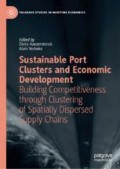Abstract
Many ports have become more functionally integrated with their hinterlands, with ports acting as “impact hubs” for a broad region. The new economic geography of port impacts, which have become more spatially dispersed than in the past, is imposing new contractual relationship challenges on ports and on the various economic actors in their hinterland with whom contractual relationships need to be crafted and fine-tuned. A contractual relationship refers to any economic exchange between two or more parties whereby these parties face the challenge of jointly selecting the most efficient “governance structure” for this exchange, given the characteristics of the transaction at hand. The presence of relationship-specific investments associated with an exchange, that is, dedicated investments that cannot be easily redeployed elsewhere without loss of economic value, calls for more complex contractual relations, and the extreme case being that of internalization.
Access this chapter
Tax calculation will be finalised at checkout
Purchases are for personal use only
References
Bryan, J., Munday, M., Pickernell, D., & Roberts, A. (2006). Assessing the economic significance of port activity: Evidence from ABP operations in industrial South Wales. Maritime Policy and Management, 33(4), 371–386.
Charlier, J. (2011). Hinterlands, port regionalisation and extended gateways: The case of Belgium and Northern France. In P. Hall, R. McCalla, C. Comtois, & B. Slack (Eds.), Integrating seaports and trade corridors. Burlington-Farnham: Ashgate.
Cullinane, K., Bergqvist, R., & Wilmsmeier, G. (2012). The dry port concept—Theory and practice. Maritime Economics & Logistics, 14(1), 1–13.
De Brucker, K., Verbeke, A., & Winkelmans, W. (1998). Sociaal-economische evaluatie van overheidsinvesteringen in transportinfrastructuur. Leuven: Garant.
Dooms, M., & Verbeke, A. (2006). An integrative framework for long-term strategic seaport planning: An application to the port of Antwerp. In T. Notteboom (Ed.), Ports are more than piers. Liber Amicorum presented to Prof. Dr. Willy Winkelmans (pp. 173–192). Antwerp, BE: De Lloyd.
Dooms, M., Haezendonck, E., & Verbeke, A. (2010). Towards a toolkit for port related socio-economic impacts: A meta-analysis of socio-economic impact studies conducted for seaports. Edition: Econship 2011. Chios, Greece.
Gripaios, P., & Gripaios, R. (1995). The impact of a port on its local economy: The case of Plymouth. Maritime Policy & Management, 22(1), 13–24.
Haezendonck, E. (2007). Transport project evaluation: Extending the cost-benefit approach. Chaltenham: Edward Elgar Publishing.
Haezendonck, E., Dooms M., & Verbeke, A. (2009). Green benchmarking: Green portfolio analysis as a strategic tool for competitive positioning. Paper submitted for the 2009 Academy of Management Conference.
Hall, P. V., & Jacobs, W. (2012). Why are maritime ports (still) urban, and why should policy-makers care? Maritime Policy & Management, 39(2), 189–206.
Haralambides, H., & Gujar, G. (2011). The Indian dry ports sector, pricing policies and opportunities for public-private partnerships. Research in Transportation Economics, 33(1), 51–58.
Iannone, F. (2012). The private and social cost efficiency of port hinterland container distribution through a regional logistics system. Transportation Research Part A: Policy and Practice, 46(9), 1424–1448.
McCalla, R. J. (1999). Global change, local pain: Intermodal seaport terminals and their service areas. Journal of Transport Geography, 7(4), 247–254.
Notteboom, T., & Rodrigue, J. P. (2005). Port regionalization: Towards a new phase in port development. Maritime Policy and Management, 32(3), 297–313.
Robinson, R. (2002). Ports as elements in value-driven chain systems: The new paradigm. Maritime Policy & Management, 29(3), 241–255.
Roso, V., & Lumsden, K. (2010). A review of dry ports. Maritime Economics & Logistics, 12(2), 196–213.
Roso, V., Woxenius, J., & Lumsden, K. (2009). The dry port concept: Connecting container seaports with the hinterland. Journal of Transport Geography, 17(5), 338–345.
van der Horst, M. R., & van der Lugt, L. M. (2011). Coordination mechanisms in improving hinterland accessibility: Empirical analysis in the port of Rotterdam. Maritime Policy & Management, 38(4), 415–435.
van der Lugt, L., Dooms, M., & Parola, F. (2013). Strategy making by hybrid organisations: The case of the port authority. Research in Transportation Business & Management, 8, 103–113.
Veenstra, A., Zuidwijk, R., & van Asperen, E. (2012). The extended gate concept for container terminals: Expanding the notion of dry ports. Maritime Economics & Logistics, 14(1), 14–32.
Verbeke, A. (2013). International business strategy: Rethinking the foundations of global corporate success. Cambridge, UK: Cambridge University Press.
Verbeke, A., & Dooms, M. (2008). Integrating the extended gateway concept in long-term strategic seaport planning: A European case study. Conference Proceedings of the Van Horne Institute’s 2007 Pacific Gateway Round Table. Canada: University of Calgary.
Verbeke, A., & Greidanus, N. (2009). The end of the opportunism versus trust debate: Bounded reliability as a new envelope concept in research on MNE governance. Journal of International Business Studies, 40, 1471–1495.
Verhoeven, P. (2010). A review of port authorirty functions: Towards a renaissance? Maritime Policy and Management, 37(4), 247–270.
VIL (Flanders Institute for Logistics). (2006). Annual report 2005. Antwerp: VIL.
Wang, C., & Ducruet, C. (2012). New port development and global city making: Emergence of the Shanghai-Yangshan multilayered gateway hub. Journal of Transport Geography, 25, 58–69.
Williamson, O. E. (1979). Transaction-cost economics: The governance of contractual relations. Journal of Law and Economics, 22, 233–261.
Williamson, O. E. (1996). The mechanisms of governance. Oxford: Oxford University Press.
Acknowledgements
Data for the Zeebrugge empirical case in this chapter were collected by the authors through the EU-supported IMPACTE study (Intermodal Ports Access and Commodities Transport in Europe—The Economic Role of Ports, 2008).
Author information
Authors and Affiliations
Corresponding author
Editor information
Editors and Affiliations
Rights and permissions
Copyright information
© 2018 The Author(s)
About this chapter
Cite this chapter
Haezendonck, E., Dooms, M., Verbeke, A. (2018). A New Governance Perspective on Port–Hinterland Relationships: The Port Hinterland Impact (PHI) Matrix. In: Haezendonck, E., Verbeke, A. (eds) Sustainable Port Clusters and Economic Development. Palgrave Studies in Maritime Economics. Palgrave Macmillan, Cham. https://doi.org/10.1007/978-3-319-96658-8_2
Download citation
DOI: https://doi.org/10.1007/978-3-319-96658-8_2
Published:
Publisher Name: Palgrave Macmillan, Cham
Print ISBN: 978-3-319-96657-1
Online ISBN: 978-3-319-96658-8
eBook Packages: Economics and FinanceEconomics and Finance (R0)

